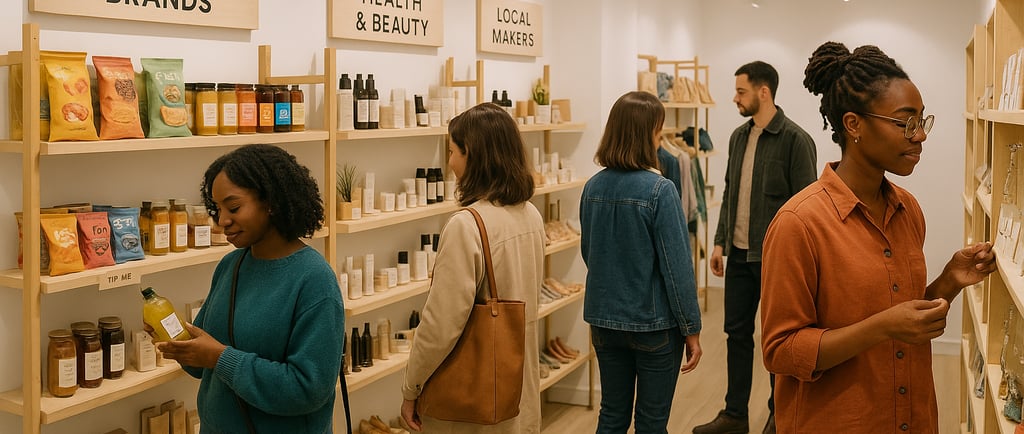Can Rent-A-Shelf Models Work for New Brands in the UK?
As retail costs climb and traditional shelf space becomes increasingly competitive, many emerging brands are turning to rent-a-shelf models as a practical entry strategy. For product categories like FMCG, health and beauty, and fashion and accessories, this model provides a lower-risk alternative to full-scale retail launches—especially in the dynamic, fragmented environment of the UK’s independent retail and off-licence sector.
RETAILFMCG
Anil Junagal
7/26/20253 min read


Understanding the Rent-A-Shelf Model
In this model, brands lease shelf or rail space within an existing retail store for a fixed fee—typically ranging from £20 to £45 per month. Some retailers use a hybrid structure, combining rental fees with a small commission on sales (e.g. £35 per month + 10%).
This model differs significantly from traditional distribution approaches that often demand:
Slotting fees of £350–£500 per store,
Wholesaler listing costs starting at £2,000,
Marketing and POS investments of £5,000 or more.
For brands operating on lean budgets, rent-a-shelf presents a leaner, faster route to market.
How the Model Works for Each Sector
1. FMCG (Fast-Moving Consumer Goods)
Rent-a-shelf allows niche food, drink, or packaged product brands to test demand without a national distribution contract. Ideal for local flavours or unique SKUs, it helps gather feedback quickly.
Challenge: High-frequency replenishment and thinner margins mean the rental cost must be carefully weighed against real turnover. Visibility is key, and shelf clutter can be an obstacle.
2. Health & Beauty
This is perhaps the most compatible category for rent-a-shelf. From skincare and cosmetics to supplements, products gain credibility when seen and touched.
Advantage: Strong visual merchandising and sampling potential—both critical in driving trial and trust—can be managed directly by the brand. Rent-a-shelf allows premium or emerging wellness brands to punch above their weight.
3. Fashion & Accessories
From handmade jewellery to seasonal scarves, boutique fashion items thrive in curated, multi-brand retail settings. Rent-a-rail or shared retail models enable emerging designers to establish retail credibility, gauge in-person feedback, and build community appeal.
Watchpoint: These products need high-quality displays and secured environments. Theft, damage, and branding dilution are potential concerns.
Strategic Benefits for New Brands
✅ Reduced Financial Risk
Compared to a traditional £7,000+ retail entry cost per store, monthly rent-a-shelf fees starting at £20 enable lean testing and capital preservation.
✅ Local Market Testing
Brands can evaluate regional demand, fine-tune packaging or price points, and pivot quickly based on real-world data—ideal for early-stage product validation.
✅ Retail Visibility Without a Retail Team
The host retailer handles day-to-day operations, freeing up brand founders to focus on supply, marketing, or online sales.
✅ Build Brand Trust Through Tangibility
In sectors like beauty or accessories, physical presence creates emotional connection—a benefit online-only sales often lack
Operational Considerations
Success in a rent-a-shelf model relies on:
Consistent replenishment and inventory control
Attractive, informative displays
Ongoing relationship management with the host store
Clear brand storytelling using shelf cards or QR links
Emerging platforms like ShopShare and Shelfleet are enabling smarter shelf matchmaking across UK retail locations.
ThirdRetail’s Perspective
At ThirdRetail, we believe that smart, accessible retail placement is essential to democratize brand discovery. The rent-a-shelf model represents a powerful interim solution—but one that benefits from data-driven shelf strategy.
Our platform empowers emerging FMCG, health & beauty, and fashion brands by:
Predicting store-level footfall alignment
Suggesting location-specific shelf partners
Enabling performance tracking across micro-retail networks
While we don't manage shelf rentals, we help brands identify where to invest shelf space wisely—using insight over instinct.
Real-World Examples
Crafty Cuppa: Local venues like this allow small-batch skincare or handmade accessories to reach new audiences for just £25/month.
Pop-Up Events: Seasonal activations in galleries or cafes can serve as testbeds for beauty brands or artisan snacks.
Salons and Boutiques: High-footfall locations for haircare and personal accessories, often willing to cross-promote new products.
Conclusion
The rent-a-shelf model is not a silver bullet, but for many new UK brands in the FMCG, health & beauty, and fashion sectors, it provides a low-risk, high-potential pathway to gain exposure and learn fast.
Done right, it creates a stepping stone to larger wholesale or retail agreements by validating demand, collecting feedback, and building early customer loyalty.
In a time where retail shelf space is costly, competitive, and constrained, brands that take a strategic, data-informed approach to rent-a-shelf are better positioned to not only survive—but thrive.
Strategy, operations, and digital transformation for modern enterprises.
Info@junagal.com
© 2025. All rights reserved.
